10 WORKOUTS TO GET STRONGER, SCULPTED LEGS
Fitness Tips
Mar 21, 2024 • 16min read
Building strong legs is fundamental for every fitness routine. Whether you’re aiming for your personal best or seeking to enhance your appearance and confidence, crafting powerful legs is a rewarding journey. The leg workouts below are tailored for everyone, regardless of fitness level, to elevate leg day. This diverse mix of exercises include a selection of weightlifting, bodyweight and high-intensity workouts to banish monotony on your fitness journey. So, tie your sneakers and get ready to embark on this leg-strengthening adventure with us.
WHAT YOU WILL LEARN:
PREPARING YOUR LEGS FOR THE WORKOUT AHEAD
A leg day warm-up is crucial for injury prevention and peak performance. This essential step enhances muscle elasticity, reduces stiffness and safeguards against sprains and strains, ensuring you can safely maximize your workout. A thorough warm-up primes your legs for exercise and gets you ready to confidently hit leg day!
Leg-Day Warm-Ups
Dynamic Stretching
- Leg Swings: Stand next to a wall for balance. Swing one leg forward and back 15 times, then side-to-side 15 times with controlled movements. Repeat with your other leg for a total of 2 minutes.
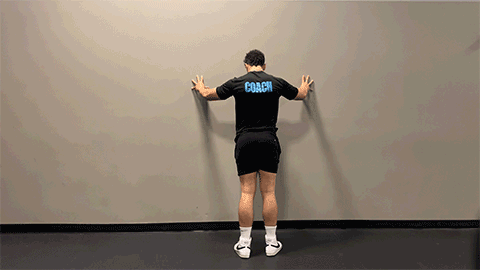
- Inchworms: Start standing upright. Hinge at your hips, hands to the ground and walk them forward to a plank. Walk your feet to your hands, stand up and repeat for 8-10 reps for 2 minutes.
- Lunges with a Twist: Start with your feet hip-width apart. Step into a lunge and twist towards the front leg. Return to standing, alternate legs and complete 12 lunges per side for 2-3 minutes.

Cardio Exercises (5-10 minutes):
- Light Jog or Stationary Bike: Focus on gradually increasing your heart rate and body temperature over 3-4 minutes, preparing your muscles for the workout.
Conclude with Activation Exercises (4-5 minutes):
- Bodyweight Squats: Stand with feet shoulder-width apart. Squat while keeping your chest up and back straight. Stand up through your heels, doing 20-25 squats in 2 minutes.

- Walking Lunges: Start with your feet together. Step forward into alternating lunges. Continue for 24 total lunges (12 per leg) for 2 minutes.

- Glute Bridges: Lie on your back with your knees bent. Lift your hips up, squeezing your glutes, then lower back down. Do 20-25 reps in 1-2 minutes.

10 LEG DAY EXERCISES TO STRENGTHEN & SCULPT
The below list of exercises caters to all fitness levels, focusing on a total lower-body workout. With a balanced mix of dynamic movements and weighted exercises, these ten leg exercises will enhance muscle tone, functionality and stability, boosting your lower body strength.
1. Squats: The Ultimate Leg Builder
Squats are a cornerstone exercise in strength training, celebrated for their comprehensive benefits to leg development. This compound movement engages the major muscle groups of the lower body, including the quads, hamstrings, glutes and calves, making it a powerhouse for building strength, improving flexibility and enhancing overall athleticism.
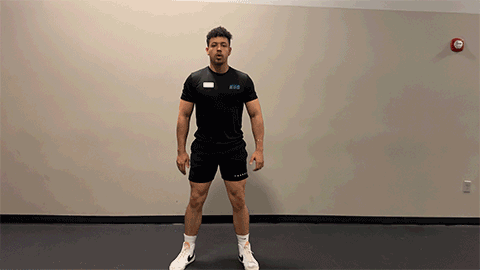
- Basic Front Squat (Bodyweight): Stand with your feet apart and arms forward. Squat, moving your hips back and keeping your knees over your toes. Then rise, keep your core tight and arms straight.
- Sumo Squats: Stand with your feet wide and toes out. Clasp your hands for balance, squat low, move your hips back and keep your chest up. Rise, driving through your heels, keeping your knees wide and aligned with your toes.
- Bulgarian Split Squat: Stand in front of a bench and place one foot back on it. Lower into a squat with the front thigh parallel to the floor and keep your front knee over your toes. Push up through the front heel, keeping your core engaged.
Benefits of Squats
- Strengthens the Lower Body: Squats target multiple muscle groups in your lower body, improving muscle mass and strength.
- Improves Balance and Stability: Performing squats also engages your core, helping to improve your balance and stability.
- Increases Flexibility: Regular squatting increases joint flexibility, particularly in the hips, knees and ankles.
- Boosts Athletic Performance: The functional strength gained from squatting can translate into improved performance in other sports and daily activities.
2. Lunges: Leg and Glute Activation
Lunges are a highly versatile and effective exercise targeting the lower body, offering numerous benefits for both leg and glute activation. This exercise is celebrated for strengthening and toning the legs and glutes, improving core stability and enhancing balance and coordination.
Forward Lunges: Start with your feet together and step forward into a lunge, keep your front knee over your ankle. Don’t let your back knee touch the floor. Press into your front heel to stand and alternate legs.
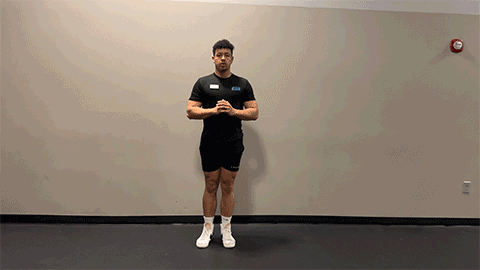
Reverse Lunges: Stand with your feet hip-width apart and step back into a lunge. Keep your front thigh parallel to the floor and front knee over ankle. Push through your front heel to stand and switch legs.

Lateral Lunges: Start with your feet together and step out to the side. Bend one knee and push your hips back. Keep the other leg straight with your knee over your foot. Push off to return to start and alternate sides.

Benefits of Lunges
- Promote Balanced Muscle Growth: Lunges work each leg independently due to their unilateral nature, helping correct muscle imbalances and ensure equal strength development.
- Engage Multiple Muscle Groups: Lunges target the quads, hamstrings, glutes and calves, and core for stabilization.
- Adaptable to Various Fitness Levels: Lunges can be tailored to fit any fitness goal, making them suitable for inclusion in daily routines.
- Enhance Muscle Endurance and Strength: Regular practice improves endurance and strength in the targeted muscles.
3. Deadlifts: Powerlifting for Leg Strength
Deadlifts are essential for strengthening the legs and back, targeting the posterior chain to increase muscle mass, grip strength, posture and core stability. Proper technique is crucial to maximize benefits and minimize injury risks. Remember to lift with your legs and hips, keep your spine neutral and avoid rounding your back. It’s essential to start with light weights, gradually increasing with safety gear like belts and shoes for enhanced performance and care.
Romanian Deadlifts
- Start Position: Begin with feet hip-width apart, holding a barbell in front of your thighs with an overhand grip. Your knees should be slightly bent.
- Movement: Hinge at your hips to lower the barbell down the front of your legs, keeping it close to your body. Lower until you feel a stretch in your hamstrings, maintaining a slight knee bend throughout.\
- Return: Drive through your heels, extending your hips to return to the starting position. Keep your back straight and core engaged throughout the movement.
Sumo Deadlifts
- Start Position: Stand with your feet wider than shoulder-width apart, toes pointing outwards. Grip the barbell with your hands inside your legs.
- Movement: Bend at the knees and hips to lower down and grasp the bar, keeping your chest up and back straight. Your thighs should be almost parallel to the floor.
- Return: Drive through your heels, straightening your legs and hips to lift the barbell up to the starting position. Ensure your back remains neutral and keep your core engaged throughout the lift.
Benefits of Deadlifts:
- Strengthen Legs and Back: Deadlifts target the posterior chain, enhancing lower body and back strength.
- Increase Muscle Mass and Grip Strength: Deadlifts promote muscle growth and improve grip through regular lifting.
- Improve Posture and Core Stability: The exercises strengthen back muscles and core, leading to better posture and reduced injury risk.
4. High-Intensity Interval Training (HIIT): Building Cardiovascular Endurance
High-intensity interval training (HIIT) is a dynamic workout method that excels in leg development, boosts cardio health and accelerates fat loss efficiently. HIIT optimizes calorie expenditure and ramps up metabolic rates by cycling through intense activity bursts and brief rest or lower-intensity phases. This approach enhances overall fitness and aids in leg sculpting. HIIT’s versatility allows it to be tailored for many fitness levels, offering easier exercises for novices or more intensity for experienced athletes, ensuring improvements in leg strength and cardio endurance that are accessible to all.
Burpees: Stand with your feet apart. Squat, place hands down, kick back into a plank, and do a push-up. Jump back to a squat, then leap up with your arms overhead.
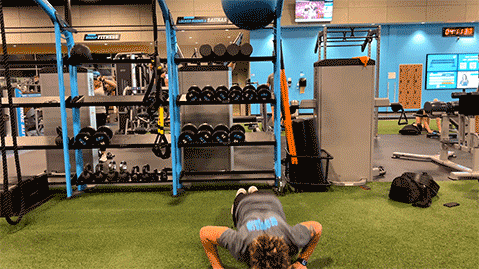
Modified Burpee: Stand with your feet apart, squat to place hands down, step back into plank, perform a push-up (knees optional), step back to squat, and stand up, reaching your arms overhead.
Jump Squats: Start in a squat with your back straight. Jump up with arm assistance. Land back in squat softly.

Modified Jump Squat: Stand with your feet shoulder-width apart, squat down, keeping your weight in your heels, then stand up partially and do a small hop, landing softly back in your squat position.
High Knees: Stand with your feet apart. Run in place, knees high, arms moving.
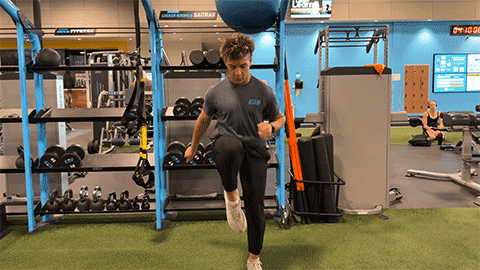
Modified High Knees: Stand upright and march in place, lifting your knees high at a moderate pace, engaging your core while maintaining a straight posture.
Push-Ups with Shoulder Taps: Start in a plank with your hands shoulder-width apart. Do a push-up, elbows in. At the top, tap each shoulder with the opposite hand.

Modified Push-Ups with Shoulder Taps: Begin in a knee-supported push-up position, lower your body towards the floor, push back up, and then tap each shoulder alternately with the opposite hand while keeping your body stable.
Benefits of HIIT Workouts:
- Enhance Leg Development and Cardiovascular Health: HIIT targets legs with specific exercises while improving heart and lung function for increased endurance.
- Accelerate Fat Loss and Metabolism: Maximizes calorie burn during and after workouts for efficient weight management and higher metabolic rates.
- Adaptable Across Fitness Levels: Modifications make these exercises accessible to beginners and challenging for enthusiasts.
- Versatile and Engaging Workouts: HIIT incorporates a wide range of exercises to maintain interest and effectiveness.
5. Leg Press: Targeted Muscle Building
The leg press machine is a staple in gyms for good reason. It offers a focused platform to strengthen and sculpt the legs, providing a controlled environment to target specific muscle groups without the balance requirements of free weights. Its design allows for heavy lifting with reduced risk of injury, making it ideal for beginners and advanced athletes looking to build muscle mass and improve leg strength.
Targeting Muscle Groups with Foot Placement Variations
Adjusting your stance and foot placement allows you to emphasize different muscle groups, creating a comprehensive leg workout tailored to specific fitness goals. This versatility makes the leg press an essential tool for enhancing lower body strength and appearance.
Wide Stance: A wide stance emphasizes the inner thigh muscles and glutes.
- Start Position: Sit on the leg press machine with your back and head against the padded support. Place your feet on the sled wider than shoulder-width, with toes slightly pointed out.
- Movement: Slowly lower the sled by bending your knees until they are at about a 90-degree angle.
- Return: Press through your heels to extend your legs and push the sled back to the starting position.
Narrow Stance: A narrow stance more intensely targets the outer thighs and quadriceps.
- Start Position: Position your feet on the sled closer than shoulder-width apart, with toes pointing forward.
- Movement: Bend your knees to lower the sled, maintaining a narrower angle than your wide stance.
- Return: Extending your legs, push the sled back to the starting position.
Benefits of the Leg Press Machine
- Isolate Lower Body: This machine concentrates on leg muscles, eliminating balance and stabilization concerns.
- Encourage Symmetrical Development: The leg press promotes even muscle development across both legs.
- Safely Manage Heavier Weights: A machine safely supports significant weight load for muscle growth and increased strength.
6. Calf Raises: Sculpting Lower Legs
Calf raises target the calf muscles (gastrocnemius and soleus), essential for leg mobility, stability, strength and helps prevent injuries by stabilizing ankle and knee joints. For effective calf development, include calf raises 2-3 times a week in your routine, starting with 3 sets of 12-15 reps each. Increase volume or weight as strength improves to stimulate growth effectively.
Heel Raises: Stand on a step with your heels off the edge. Press down through the balls of your feet to lift your heels high and engage your calves. Lower your heels below the step for one rep.

Seated Calf Raises: Sit with a weight on your lap and your feet on a platform. Push through the balls of your feet to lift the weight, focusing on using your calf muscles. Lower back to start.

Leg Press Calf Raises: Sit in a leg press machine with your feet apart on the sled. Extend your legs, pushing through the balls of your feet to lift the sled. Lower slowly back.

Benefits and Importance of Calf Development
- Improve Lower Body Function: Strengthening calf muscles enhances overall lower body performance.
- Support Stable Movements: Improved calf strength leads to more stable and efficient walking, running and jumping.
- Prevent Injuries: Well-developed calves improve balance, reduce Achilles tendon strain, and support the lower leg in daily activities and sports.
7. Plyometric Exercises: Building Explosive Strength
Plyometric exercises, or “plyos,” boost power, speed and agility through explosive movements and the stretch-shortening cycle, enhancing athletic performance and neuromuscular efficiency. Incorporating plyos into workouts can improve quick direction changes, increase short burst speed and make daily activities and sports more effective.
Box Jumps: Face a sturdy box with feet apart. Squat slightly, then jump onto the box with arm support to propel yourself forward. Step down and get ready for the next jump.

Jump Squats: Start in a squat with your feet apart. Jump up with arm momentum. Land softly back in a squat.
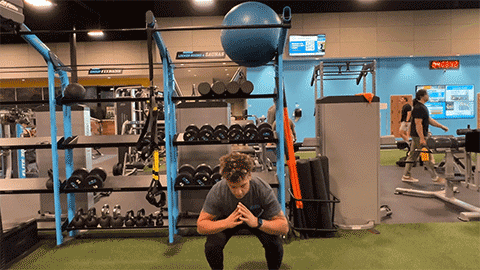
Bounding: Run forward, exaggerating each stride for forward and upward motion. Continue for the set distance or bounds. Focus on control and balance.
Benefits of Plyometrics
- Enhance Muscular Power and Explosiveness: Plyometrics improve the strength and speed of muscle contractions, leading to greater power in movements.
- Improve Agility: The dynamic nature of plyometric exercises enhances the ability to change direction swiftly, which is crucial for many sports and physical activities.
- Increase Efficiency of Movements: Regular plyometric training can lead to more efficient movement patterns, benefiting performance across various physical activities.
8. Glute Bridges and Hip Thrusts: Growing Stronger Glutes
Glute exercises strengthen and define the backside to improve leg stability and support movements like walking and jumping. Strengthening the glutes aids pelvic alignment and back support, reduces injury risk, enhances athletic performance and improves balance and activity efficiency.
Proper Form and Progression Techniques
For both exercises below, maintain a neutral spine and tucked chin during exercises to avoid neck and back strain. Begin with body weight, then gradually add weight as your strength improves. Prioritize movement quality and full range, emphasizing a strong glute squeeze at the top of each rep for optimal benefits.
Glute Bridge: Lie on your back, knees bent and feet flat. Push through your heels to lift your hips, squeezing your glutes at the top. Lower your hips to start for one rep.

Hip Thrust: Sit with your shoulders against a bench, barbell over your hips and knees bent. Drive through your heels to extend your hips, lifting the weight, and squeeze your glutes at the top. Lower to start for one rep.
Benefits of Glute Bridges & Hip Thrusts
- Improve Posture and Core Stability: Strengthening these muscles can enhance posture and provide core stability.
- Enhance Athletic Performance: Glutes contribute to increased power generation and performance in various athletic activities.
- Prevent Injuries: Strengthening the glutes and hamstrings helps prevent injuries, particularly in the lower back, hips and knees.
- Versatile and Progressive: With variations and progression options, these exercises cater to different fitness levels and goals for continuous improvement.
9. Stair Climbing Machine: Everyday Leg Workouts
The stair climbing machine is an efficient leg workout that combines cardio endurance with lower-body strength for a full lower-body workout and improved aerobic fitness. It can be seamlessly incorporated into daily routines using a stair-climbing machine at the gym for 15-20 minutes. It’s an excellent way to build endurance and strengthen the lower body without additional weights. Adjust the machine’s settings to vary the intensity of the workout, making it suitable for all fitness levels.
Stair Climb Workouts
- Steady Climb: Involves a steady 20-30 minute pace, ideal for endurance and easy to include in daily routines, like opting for stairs over elevators.
- Interval Climb: Alternating fast climbing for 1-2 minutes with slower recovery for 2-3 minutes over 20-30 minutes, boosting cardiovascular fitness and leg endurance.
Benefits of Stair Climbing Machine Workouts
- Improve Cardiovascular Health: Stair climbing improves cardiovascular health and strengthens the heart, reducing the risk of cardiovascular diseases.
- Increase Lower Body Strength: Stair climbs target the full range of lower body muscles, including the quadriceps, hamstrings, glutes and calves, improving strength and endurance.
- Minimize Impact: Stair climbing is gentle on joints and suitable for individuals with joint pain or recovering from injuries.
- Versatile: Versatile machine settings allow speed and intensity adjustment, catering to users of all fitness levels.
10. Resistance Band Leg Workouts: Leg Strength and Flexibility
Resistance band training is versatile and effective to enhance leg strength and flexibility. These bands provide variable resistance throughout exercises, challenging your muscles in a way that’s different from free weights or machines. The elasticity of the bands helps improve both the strength and flexibility of the muscles, offering a full range of motion and targeting various muscle groups effectively.
Lateral Walk: Place a resistance band above your knees and squat slightly—sidestep, keeping the band tense—alternate directions after several steps.

Monster Walk: Place the resistance band around your ankles with your knees slightly bent. Step diagonally forward, then back, mimicking a monster’s stride.

Banded Squats: Place the resistance band above your knees with your feet apart. Squat, pushing knees out, then stand through heels.
Banded Leg Curls: Lie flat on your back, loop a resistance band around your feet, then slowly curl your legs towards your glutes while keeping your core engaged.

Benefits of Resistance Band Training
- Adaptable Resistance: As you stretch the band, the resistance increases, challenging your muscles through their full range of motion.
- Versatile: Resistance bands can be used for a wide range of exercises, targeting every major muscle group in the legs.
- Portable and Convenient: Lightweight and compact, resistance bands are ideal for workouts at home, in the gym or while traveling.
- Improve Flexibility and Mobility: The bands build strength and enhance flexibility and joint mobility through stretching and active recovery exercises.
YOGA AND STRETCHING FOR LEG RECOVERY
Incorporating yoga and stretching into a fitness regimen is crucial for leg workout recovery. These practices aid in alleviating muscle tension, enhancing blood circulation and improving flexibility, essential for repairing and strengthening muscles post-exercise. Yoga and stretching can also significantly reduce soreness, making it easier to maintain a consistent training schedule.
Downward Dog: Begin on your hands and knees with your hands slightly ahead of your shoulders. Lift your knees, extend your tailbone, press your heels down and straighten your legs without locking, focusing on arm and leg stretch before releasing.
Pigeon Pose: From Downward Dog, bring your right knee forward to touch the right wrist, angle your right foot towards your left hand and extend your left leg back. Lower your torso to deepen the stretch in the right glute, then gently release and switch legs.
Warrior II: Stand with your feet apart and arms parallel to the floor. Turn your right foot slightly and your left foot out 90 degrees, aligning your heels. Bend your left knee over your ankle, keeping your shin perpendicular to the floor, then switch sides.
CRAFTING YOUR IDEAL LEG WORKOUT ROUTINE
Crafting an effective leg workout requires a thoughtful selection of exercises tailored to your goals and preferences. Incorporating a variety of movements such as squats, lunges, deadlifts, plyometrics and machine exercises ensures thorough activation of all major leg muscles, encouraging balanced growth and strength development. Consistent training, paired with rest and recovery, is important for optimizing muscle growth and achieving desired results. Tracking progress over time enables you to gauge improvements, adjust intensity levels, and refine your routine for continued leg sculpting success.
Elevate your leg training with a Membership at EōS Fitness, gaining access to state-of-the-art equipment and classes that enhance leg development. Meet with one of our Personal Trainers to get the personalized support you need to create a consistent routine. Join EōS Fitness to build a challenging leg routine in a supportive environment, moving closer to your fitness goals.







